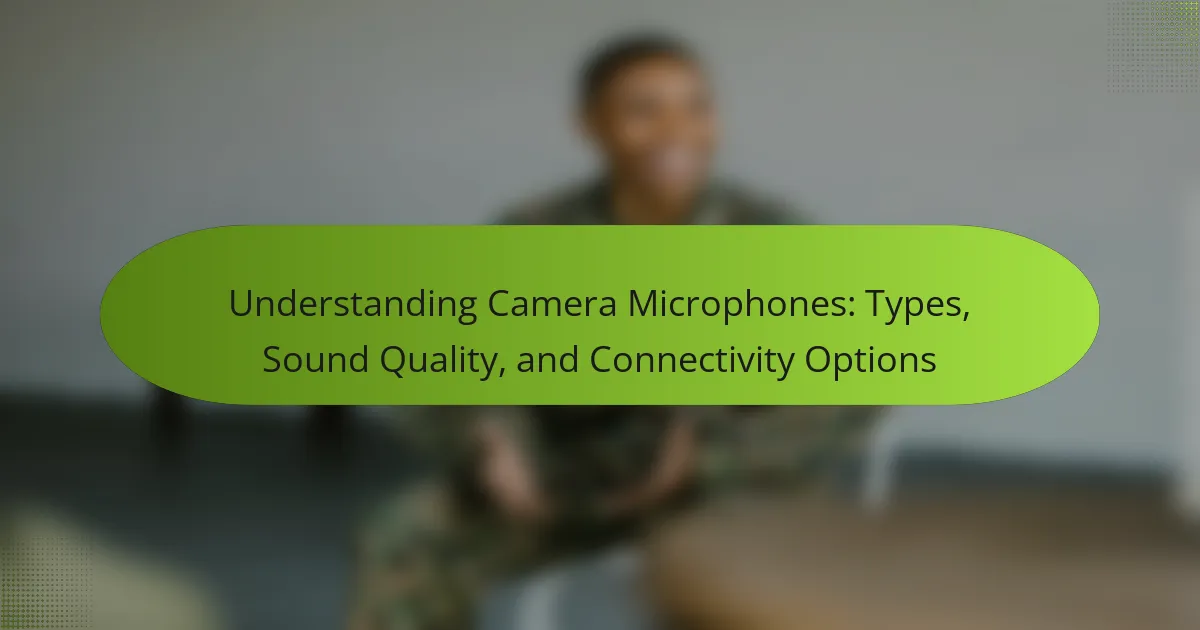Camera microphones are specialized audio devices designed to capture sound alongside video recording equipment, significantly enhancing audio quality by isolating sound sources and minimizing background noise. This article explores various types of camera microphones, including shotgun, lavalier, and handheld microphones, each suited for different recording scenarios. It emphasizes the critical impact of sound quality on video production, noting that superior microphones contribute to clearer audio capture, which is essential for viewer engagement. Additionally, the article outlines the connectivity options available for camera microphones, such as wired connections (XLR, TRS, TRRS) and wireless solutions (Bluetooth, dedicated transmitters), highlighting their relevance in various recording contexts.
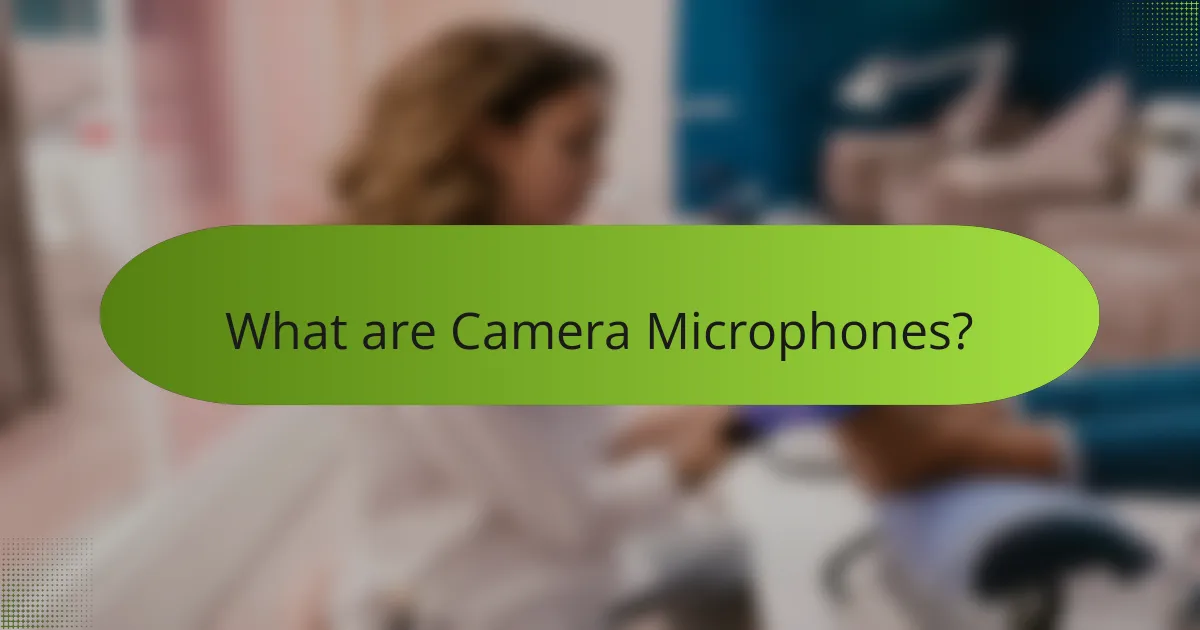
What are Camera Microphones?
Camera microphones are audio devices specifically designed to capture sound in conjunction with video recording equipment. They enhance audio quality by isolating sound sources and reducing background noise. These microphones can be built into cameras or used externally. Popular types include shotgun, lavalier, and handheld microphones. Shotgun microphones are highly directional, making them ideal for focused sound capture. Lavalier microphones are small and clip onto clothing, allowing for hands-free operation. Handheld microphones are often used in interviews and on-the-go recording. The choice of microphone affects overall sound quality significantly, influencing the recording outcome.
How do Camera Microphones differ from other types of microphones?
Camera microphones are specifically designed to capture sound in conjunction with video recording equipment. They often feature built-in windshields to reduce noise from wind and other environmental factors. Additionally, camera microphones typically have a compact form factor to fit seamlessly with cameras. Many camera microphones use shotgun or lavalier designs for targeted audio capture. In contrast, other types of microphones, such as studio or handheld microphones, may prioritize sound quality over portability. Studio microphones often require external power sources and are not designed for mobile use. This specialization in design and functionality makes camera microphones distinct from other microphone types.
What are the primary functions of camera microphones?
Camera microphones primarily capture audio during video recording. They convert sound waves into electrical signals. This process allows for synchronized sound with visual content. Camera microphones enhance sound quality compared to built-in camera mics. They can reduce background noise and focus on specific audio sources. Additionally, they enable various audio input options, such as shotgun or lavalier types. This versatility supports different filming environments and styles. Overall, camera microphones improve the overall production value of video projects.
Why are camera microphones essential for video production?
Camera microphones are essential for video production because they capture high-quality audio that complements visual content. Clear audio enhances viewer engagement and understanding. Poor sound quality can detract from the overall experience. According to a study by the University of Southern California, 70% of viewers find audio quality more important than video quality. This highlights the critical role of sound in storytelling. Additionally, camera microphones are designed to reduce background noise and focus on the subject’s voice. This specificity ensures that the intended message is conveyed effectively.
What are the different types of camera microphones?
The different types of camera microphones include shotgun microphones, lavalier microphones, and handheld microphones. Shotgun microphones are highly directional and capture sound from a specific source while minimizing background noise. They are commonly used in film and video production for capturing dialogue. Lavalier microphones, also known as lapel mics, are small and clip onto the speaker’s clothing. They provide hands-free operation and are often used in interviews and presentations. Handheld microphones are versatile and can be used in various settings, including interviews and live events. Each type serves different recording needs and environments, ensuring optimal sound capture.
What are the characteristics of shotgun microphones?
Shotgun microphones are highly directional audio recording devices. They primarily capture sound from a specific direction while minimizing background noise. Their design includes a long, narrow pickup pattern, often resembling a tube. This shape allows them to focus on sounds in front while rejecting sounds from the sides and rear. Shotgun microphones are commonly used in film, television, and field recording. They typically have a frequency response that ranges from 20 Hz to 20 kHz. Additionally, many shotgun microphones come with a windscreen to reduce wind noise during outdoor use. Their sensitivity can vary, but they generally require careful positioning for optimal sound capture.
How do lavalier microphones enhance audio capture?
Lavalier microphones enhance audio capture by providing close proximity to the speaker’s voice. This positioning minimizes background noise and captures clearer sound. Their small size allows for discreet placement, making them ideal for interviews and presentations. Lavalier microphones typically use omnidirectional patterns, picking up sound from all directions. This feature ensures consistent audio quality, even if the speaker turns their head. Many models also have windshields to reduce wind noise in outdoor settings. Additionally, wireless options offer freedom of movement without compromising sound quality. Studies show that lavalier microphones can significantly improve audio clarity compared to handheld microphones in similar environments.
What role do handheld microphones play in video recording?
Handheld microphones capture audio during video recording. They provide clear sound quality by minimizing background noise. These microphones are designed for direct use by the speaker. Their portability allows for flexibility in various recording environments. Handheld microphones often feature dynamic or condenser technology for optimal audio performance. They are commonly used in interviews, presentations, and live events. The close proximity of the microphone to the sound source enhances clarity. Their use improves overall production value in video content.
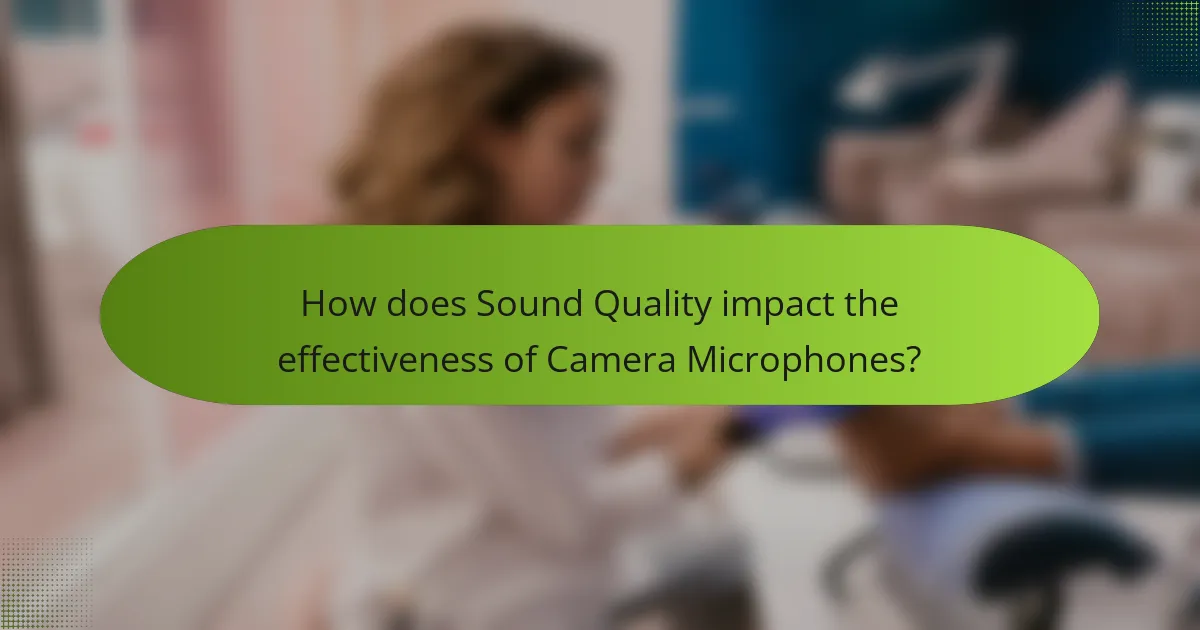
How does Sound Quality impact the effectiveness of Camera Microphones?
Sound quality significantly impacts the effectiveness of camera microphones. High sound quality ensures clear and accurate audio capture, which is essential for professional video production. Poor sound quality can lead to distortion, background noise, and loss of important audio details. This can detract from the viewer’s experience and undermine the video’s overall quality. Studies show that viewers are more likely to disengage from content with subpar audio. Effective camera microphones typically feature higher sensitivity and better frequency response, which enhance sound reproduction. Therefore, investing in quality microphones directly correlates with improved audio outcomes in video projects.
What factors influence the sound quality of camera microphones?
The sound quality of camera microphones is influenced by several factors. These include microphone type, which affects sensitivity and frequency response. Directionality plays a role in capturing sound from specific sources while minimizing background noise. The quality of the preamp in the camera can enhance or degrade audio clarity. Environmental conditions, such as wind and ambient noise, also impact sound quality. Additionally, the distance between the microphone and the sound source affects volume and clarity. Lastly, the recording format and settings can determine fidelity and overall audio performance.
How does microphone placement affect sound quality?
Microphone placement significantly affects sound quality by influencing the capture of audio frequencies and ambient noise. When positioned too close to a sound source, microphones can produce distortion and an overwhelming bass response. Conversely, placing a microphone too far can result in weak audio signals and increased background noise. The angle and direction of the microphone also play a crucial role. For instance, a microphone aimed directly at a sound source captures clearer audio compared to one positioned at an angle. Additionally, proximity to reflective surfaces can cause unwanted echoes and reverberations, further degrading sound quality. Studies show that optimal placement can enhance clarity and reduce noise interference, thereby improving overall audio fidelity.
What is the significance of frequency response in camera microphones?
Frequency response in camera microphones is crucial for capturing accurate sound. It defines the range of frequencies a microphone can pick up, from low to high. A wider frequency response allows for clearer and more detailed audio reproduction. This is particularly significant for recording vocals and musical instruments, where nuances matter. For example, a microphone with a frequency response of 20 Hz to 20 kHz can capture the full spectrum of human hearing. This enhances the overall sound quality in video production. Therefore, understanding frequency response helps users select the right microphone for their specific audio needs.
Why is audio clarity important in video production?
Audio clarity is crucial in video production because it directly affects viewer engagement and comprehension. Clear audio ensures that dialogue and sound effects are easily understood. Poor audio quality can lead to viewer distraction and frustration. According to a survey by the National Academy of Television Arts and Sciences, 70% of viewers reported that they would stop watching a video with unclear audio. Additionally, audio clarity enhances the overall production value, making the content more professional and polished. High-quality sound supports storytelling and emotional impact, reinforcing the visuals. Thus, audio clarity is essential for effective communication and audience retention in video production.
How does poor sound quality detract from video content?
Poor sound quality significantly detracts from video content by impairing viewer engagement. When audio is unclear or distorted, it becomes difficult for audiences to follow dialogue or understand key messages. This can lead to frustration and a negative viewing experience. Studies show that viewers are more likely to abandon videos with poor audio, even if the visuals are strong. A survey by Wistia indicates that 45% of viewers will stop watching a video if the audio quality is bad. Additionally, poor sound can diminish the emotional impact of the content. Clear audio is essential for conveying tone and intent, which enhances storytelling. Overall, sound quality plays a crucial role in the effectiveness of video communication.
What are the common sound quality issues faced by videographers?
Common sound quality issues faced by videographers include background noise, wind interference, and inconsistent audio levels. Background noise arises from environmental sounds that can distract from the main audio. Wind interference often occurs when recording outdoors, causing unwanted distortion. Inconsistent audio levels can result from varying distances between the microphone and the sound source, leading to fluctuations in volume. Additionally, poor microphone placement can lead to muffled or unclear audio. These issues can significantly affect the overall quality of the video production.

What are the connectivity options for Camera Microphones?
Camera microphones offer several connectivity options. These include wired connections such as XLR, TRS, and TRRS. XLR connections are commonly used in professional settings for balanced audio transmission. TRS connectors are often used for consumer-grade microphones and devices. TRRS connectors are typically found in smartphones and tablets, allowing for both audio input and output.
Wireless connectivity options include Bluetooth and dedicated wireless transmitters. Bluetooth microphones provide convenience and mobility, ideal for casual use. Dedicated wireless transmitters offer higher audio quality and reliability, often used in professional videography.
Each connectivity option serves different needs and scenarios, ensuring versatility in capturing high-quality audio.
What types of connections are available for camera microphones?
Camera microphones typically connect using three main types of connections: XLR, 3.5mm TRS, and USB. XLR connections are professional-grade and provide balanced audio, reducing noise over long distances. The 3.5mm TRS connection is common for consumer cameras, offering a simple plug-and-play option. USB connections allow for direct digital audio input to cameras that support this format. Each connection type serves different needs based on the camera system and audio requirements.
How do XLR connections differ from 3.5mm inputs?
XLR connections differ from 3.5mm inputs primarily in their design and functionality. XLR connectors are typically used in professional audio equipment. They feature three pins that provide balanced audio, reducing noise interference. This is crucial for high-quality sound in recording and live settings.
In contrast, 3.5mm inputs are commonly found in consumer electronics. They use a single unbalanced connection, which is more susceptible to noise. The 3.5mm jack is often used for headphones and portable microphones.
The XLR connection can carry phantom power, enabling the use of condenser microphones. This capability is not available with 3.5mm inputs. Additionally, XLR cables are generally more durable and designed for longer distances. This makes them suitable for professional audio environments.
In summary, the main differences lie in their application, design, and audio quality.
What are the advantages of wireless microphone systems?
Wireless microphone systems offer several advantages over traditional wired systems. They provide freedom of movement, allowing users to perform without being tethered to equipment. This flexibility is crucial for dynamic presentations or performances.
Wireless systems typically feature a longer range, enabling users to operate at greater distances from the audio source. Many models can transmit signals up to 300 feet or more, depending on the environment.
They also reduce cable clutter, creating a cleaner setup for events or productions. This can enhance safety by minimizing tripping hazards associated with cables.
Additionally, wireless microphones often come with advanced features like automatic frequency scanning. This helps users avoid interference from other wireless devices.
Overall, wireless microphone systems enhance convenience, mobility, and professionalism in audio capture.
How do connectivity options affect usability?
Connectivity options directly influence the usability of camera microphones. Various connectivity methods, such as USB, XLR, and 3.5mm jacks, determine how easily a microphone can be integrated into different recording setups. USB microphones offer plug-and-play convenience, making them user-friendly for beginners. XLR connections provide professional-grade audio quality and versatility for advanced users, but require additional equipment like mixers or audio interfaces. The choice of connectivity affects the microphone’s compatibility with devices and recording software. For instance, a 3.5mm jack is widely compatible with cameras and smartphones, enhancing portability. Conversely, limited connectivity options can restrict a microphone’s use in diverse environments. Therefore, the right connectivity option enhances usability by ensuring compatibility and ease of integration into various audio setups.
What should you consider when choosing a microphone connection type?
When choosing a microphone connection type, consider compatibility with your recording device. Different devices support various connection types such as XLR, TRS, and USB. XLR connections offer professional quality and balanced audio. TRS connections are common for consumer equipment and provide decent sound quality. USB microphones are convenient for direct computer connection. Also, assess the intended use. For studio recordings, XLR is preferred. For mobile or casual use, USB may be sufficient. Additionally, consider cable length and flexibility for your setup. Ensure that the connection type supports your sound quality requirements.
How can connectivity options impact audio performance?
Connectivity options significantly impact audio performance by determining the quality and reliability of sound transmission. Different connectivity types, such as XLR, TRS, and USB, offer varying levels of audio fidelity. XLR connections are known for their balanced audio signals, reducing noise and interference. This results in clearer sound quality, especially in professional settings.
On the other hand, USB connections provide digital audio, which can maintain high fidelity but may depend on the device’s internal processing. Wireless connectivity options, such as Bluetooth, can introduce latency and compression, potentially degrading audio performance.
Research indicates that wired connections typically outperform wireless in terms of stability and sound quality. For instance, a study by the Audio Engineering Society highlights that analog connections yield less latency compared to digital wireless systems. Thus, selecting the appropriate connectivity option is crucial for optimal audio performance.
What are some best practices for using camera microphones effectively?
To use camera microphones effectively, position the microphone close to the sound source. This minimizes background noise and captures clearer audio. Use a windscreen to reduce wind interference when recording outdoors. Ensure the microphone is securely mounted to avoid handling noise. Test audio levels before recording to prevent distortion. Utilize directional microphones to focus on specific sounds. Monitor audio through headphones during recording for immediate feedback. Lastly, maintain a consistent distance from the microphone to ensure uniform sound quality.
Camera microphones are specialized audio devices designed to enhance sound quality in video recording by isolating sound sources and minimizing background noise. This article covers various types of camera microphones, including shotgun, lavalier, and handheld microphones, and explains their unique attributes and functions. Additionally, it discusses the importance of sound quality in video production, the impact of microphone placement and connectivity options on audio performance, and best practices for effective usage. Understanding these elements is essential for achieving high-quality audio in video projects.
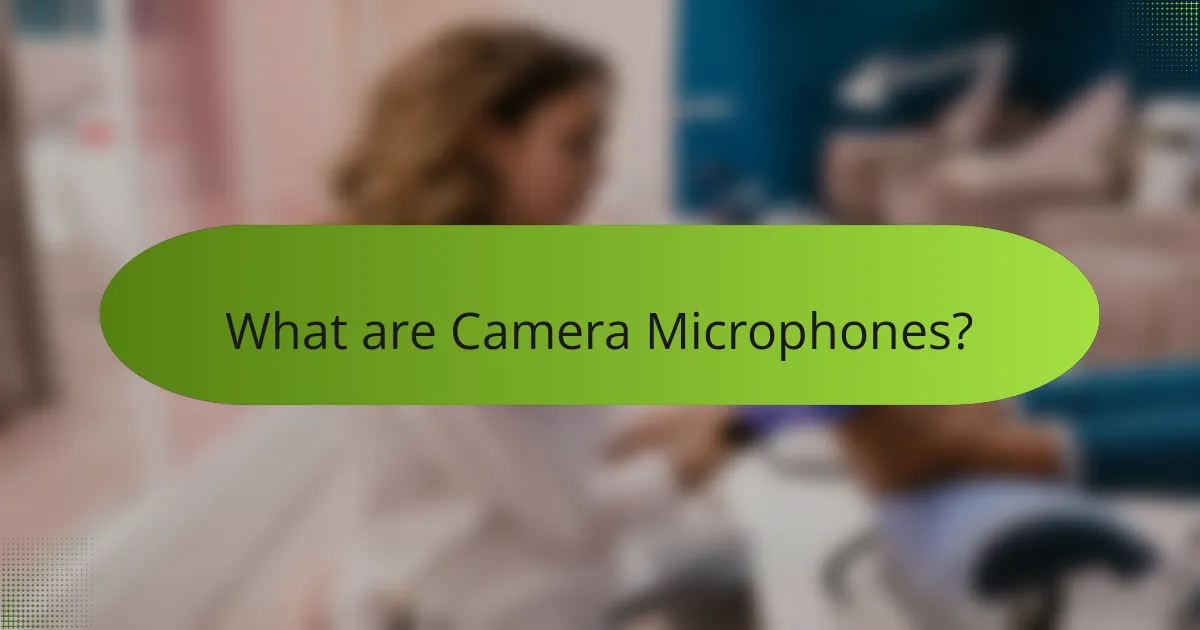
What are Camera Microphones?
Camera microphones are audio devices specifically designed to capture sound in conjunction with video recording equipment. They enhance audio quality by isolating sound sources and reducing background noise. These microphones can be built into cameras or used externally. Popular types include shotgun, lavalier, and handheld microphones. Shotgun microphones are highly directional, making them ideal for focused sound capture. Lavalier microphones are small and clip onto clothing, allowing for hands-free operation. Handheld microphones are often used in interviews and on-the-go recording. The choice of microphone affects overall sound quality significantly, influencing the recording outcome.
How do Camera Microphones differ from other types of microphones?
Camera microphones are specifically designed to capture sound in conjunction with video recording equipment. They often feature built-in windshields to reduce noise from wind and other environmental factors. Additionally, camera microphones typically have a compact form factor to fit seamlessly with cameras. Many camera microphones use shotgun or lavalier designs for targeted audio capture. In contrast, other types of microphones, such as studio or handheld microphones, may prioritize sound quality over portability. Studio microphones often require external power sources and are not designed for mobile use. This specialization in design and functionality makes camera microphones distinct from other microphone types.
What are the primary functions of camera microphones?
Camera microphones primarily capture audio during video recording. They convert sound waves into electrical signals. This process allows for synchronized sound with visual content. Camera microphones enhance sound quality compared to built-in camera mics. They can reduce background noise and focus on specific audio sources. Additionally, they enable various audio input options, such as shotgun or lavalier types. This versatility supports different filming environments and styles. Overall, camera microphones improve the overall production value of video projects.
Why are camera microphones essential for video production?
Camera microphones are essential for video production because they capture high-quality audio that complements visual content. Clear audio enhances viewer engagement and understanding. Poor sound quality can detract from the overall experience. According to a study by the University of Southern California, 70% of viewers find audio quality more important than video quality. This highlights the critical role of sound in storytelling. Additionally, camera microphones are designed to reduce background noise and focus on the subject’s voice. This specificity ensures that the intended message is conveyed effectively.
What are the different types of camera microphones?
The different types of camera microphones include shotgun microphones, lavalier microphones, and handheld microphones. Shotgun microphones are highly directional and capture sound from a specific source while minimizing background noise. They are commonly used in film and video production for capturing dialogue. Lavalier microphones, also known as lapel mics, are small and clip onto the speaker’s clothing. They provide hands-free operation and are often used in interviews and presentations. Handheld microphones are versatile and can be used in various settings, including interviews and live events. Each type serves different recording needs and environments, ensuring optimal sound capture.
What are the characteristics of shotgun microphones?
Shotgun microphones are highly directional audio recording devices. They primarily capture sound from a specific direction while minimizing background noise. Their design includes a long, narrow pickup pattern, often resembling a tube. This shape allows them to focus on sounds in front while rejecting sounds from the sides and rear. Shotgun microphones are commonly used in film, television, and field recording. They typically have a frequency response that ranges from 20 Hz to 20 kHz. Additionally, many shotgun microphones come with a windscreen to reduce wind noise during outdoor use. Their sensitivity can vary, but they generally require careful positioning for optimal sound capture.
How do lavalier microphones enhance audio capture?
Lavalier microphones enhance audio capture by providing close proximity to the speaker’s voice. This positioning minimizes background noise and captures clearer sound. Their small size allows for discreet placement, making them ideal for interviews and presentations. Lavalier microphones typically use omnidirectional patterns, picking up sound from all directions. This feature ensures consistent audio quality, even if the speaker turns their head. Many models also have windshields to reduce wind noise in outdoor settings. Additionally, wireless options offer freedom of movement without compromising sound quality. Studies show that lavalier microphones can significantly improve audio clarity compared to handheld microphones in similar environments.
What role do handheld microphones play in video recording?
Handheld microphones capture audio during video recording. They provide clear sound quality by minimizing background noise. These microphones are designed for direct use by the speaker. Their portability allows for flexibility in various recording environments. Handheld microphones often feature dynamic or condenser technology for optimal audio performance. They are commonly used in interviews, presentations, and live events. The close proximity of the microphone to the sound source enhances clarity. Their use improves overall production value in video content.
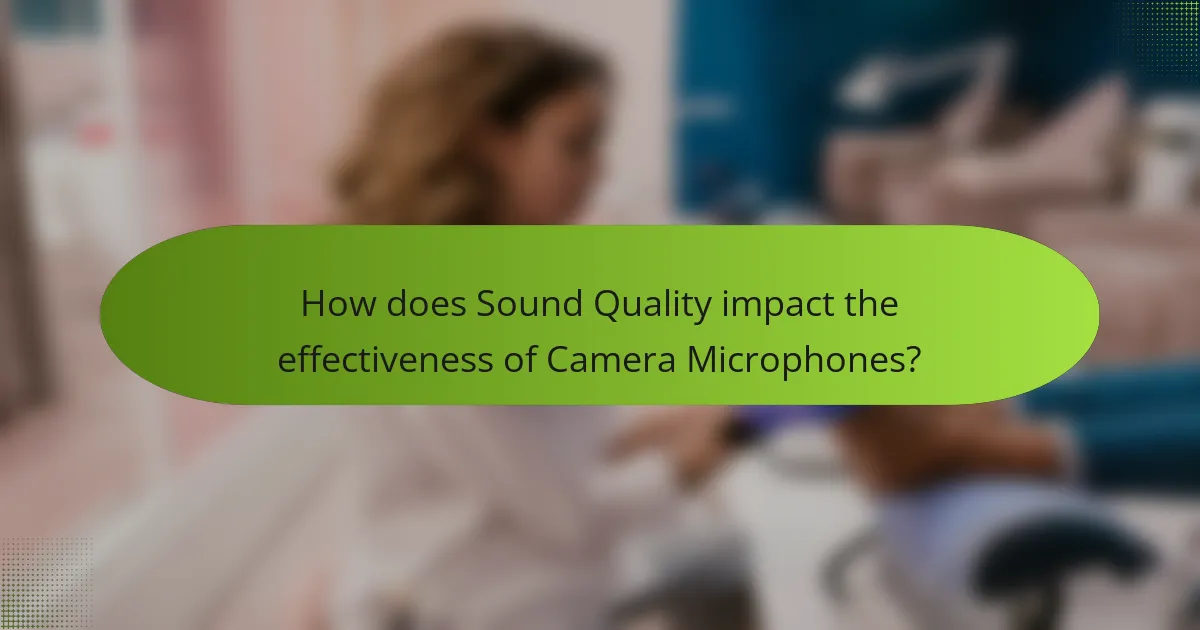
How does Sound Quality impact the effectiveness of Camera Microphones?
Sound quality significantly impacts the effectiveness of camera microphones. High sound quality ensures clear and accurate audio capture, which is essential for professional video production. Poor sound quality can lead to distortion, background noise, and loss of important audio details. This can detract from the viewer’s experience and undermine the video’s overall quality. Studies show that viewers are more likely to disengage from content with subpar audio. Effective camera microphones typically feature higher sensitivity and better frequency response, which enhance sound reproduction. Therefore, investing in quality microphones directly correlates with improved audio outcomes in video projects.
What factors influence the sound quality of camera microphones?
The sound quality of camera microphones is influenced by several factors. These include microphone type, which affects sensitivity and frequency response. Directionality plays a role in capturing sound from specific sources while minimizing background noise. The quality of the preamp in the camera can enhance or degrade audio clarity. Environmental conditions, such as wind and ambient noise, also impact sound quality. Additionally, the distance between the microphone and the sound source affects volume and clarity. Lastly, the recording format and settings can determine fidelity and overall audio performance.
How does microphone placement affect sound quality?
Microphone placement significantly affects sound quality by influencing the capture of audio frequencies and ambient noise. When positioned too close to a sound source, microphones can produce distortion and an overwhelming bass response. Conversely, placing a microphone too far can result in weak audio signals and increased background noise. The angle and direction of the microphone also play a crucial role. For instance, a microphone aimed directly at a sound source captures clearer audio compared to one positioned at an angle. Additionally, proximity to reflective surfaces can cause unwanted echoes and reverberations, further degrading sound quality. Studies show that optimal placement can enhance clarity and reduce noise interference, thereby improving overall audio fidelity.
What is the significance of frequency response in camera microphones?
Frequency response in camera microphones is crucial for capturing accurate sound. It defines the range of frequencies a microphone can pick up, from low to high. A wider frequency response allows for clearer and more detailed audio reproduction. This is particularly significant for recording vocals and musical instruments, where nuances matter. For example, a microphone with a frequency response of 20 Hz to 20 kHz can capture the full spectrum of human hearing. This enhances the overall sound quality in video production. Therefore, understanding frequency response helps users select the right microphone for their specific audio needs.
Why is audio clarity important in video production?
Audio clarity is crucial in video production because it directly affects viewer engagement and comprehension. Clear audio ensures that dialogue and sound effects are easily understood. Poor audio quality can lead to viewer distraction and frustration. According to a survey by the National Academy of Television Arts and Sciences, 70% of viewers reported that they would stop watching a video with unclear audio. Additionally, audio clarity enhances the overall production value, making the content more professional and polished. High-quality sound supports storytelling and emotional impact, reinforcing the visuals. Thus, audio clarity is essential for effective communication and audience retention in video production.
How does poor sound quality detract from video content?
Poor sound quality significantly detracts from video content by impairing viewer engagement. When audio is unclear or distorted, it becomes difficult for audiences to follow dialogue or understand key messages. This can lead to frustration and a negative viewing experience. Studies show that viewers are more likely to abandon videos with poor audio, even if the visuals are strong. A survey by Wistia indicates that 45% of viewers will stop watching a video if the audio quality is bad. Additionally, poor sound can diminish the emotional impact of the content. Clear audio is essential for conveying tone and intent, which enhances storytelling. Overall, sound quality plays a crucial role in the effectiveness of video communication.
What are the common sound quality issues faced by videographers?
Common sound quality issues faced by videographers include background noise, wind interference, and inconsistent audio levels. Background noise arises from environmental sounds that can distract from the main audio. Wind interference often occurs when recording outdoors, causing unwanted distortion. Inconsistent audio levels can result from varying distances between the microphone and the sound source, leading to fluctuations in volume. Additionally, poor microphone placement can lead to muffled or unclear audio. These issues can significantly affect the overall quality of the video production.

What are the connectivity options for Camera Microphones?
Camera microphones offer several connectivity options. These include wired connections such as XLR, TRS, and TRRS. XLR connections are commonly used in professional settings for balanced audio transmission. TRS connectors are often used for consumer-grade microphones and devices. TRRS connectors are typically found in smartphones and tablets, allowing for both audio input and output.
Wireless connectivity options include Bluetooth and dedicated wireless transmitters. Bluetooth microphones provide convenience and mobility, ideal for casual use. Dedicated wireless transmitters offer higher audio quality and reliability, often used in professional videography.
Each connectivity option serves different needs and scenarios, ensuring versatility in capturing high-quality audio.
What types of connections are available for camera microphones?
Camera microphones typically connect using three main types of connections: XLR, 3.5mm TRS, and USB. XLR connections are professional-grade and provide balanced audio, reducing noise over long distances. The 3.5mm TRS connection is common for consumer cameras, offering a simple plug-and-play option. USB connections allow for direct digital audio input to cameras that support this format. Each connection type serves different needs based on the camera system and audio requirements.
How do XLR connections differ from 3.5mm inputs?
XLR connections differ from 3.5mm inputs primarily in their design and functionality. XLR connectors are typically used in professional audio equipment. They feature three pins that provide balanced audio, reducing noise interference. This is crucial for high-quality sound in recording and live settings.
In contrast, 3.5mm inputs are commonly found in consumer electronics. They use a single unbalanced connection, which is more susceptible to noise. The 3.5mm jack is often used for headphones and portable microphones.
The XLR connection can carry phantom power, enabling the use of condenser microphones. This capability is not available with 3.5mm inputs. Additionally, XLR cables are generally more durable and designed for longer distances. This makes them suitable for professional audio environments.
In summary, the main differences lie in their application, design, and audio quality.
What are the advantages of wireless microphone systems?
Wireless microphone systems offer several advantages over traditional wired systems. They provide freedom of movement, allowing users to perform without being tethered to equipment. This flexibility is crucial for dynamic presentations or performances.
Wireless systems typically feature a longer range, enabling users to operate at greater distances from the audio source. Many models can transmit signals up to 300 feet or more, depending on the environment.
They also reduce cable clutter, creating a cleaner setup for events or productions. This can enhance safety by minimizing tripping hazards associated with cables.
Additionally, wireless microphones often come with advanced features like automatic frequency scanning. This helps users avoid interference from other wireless devices.
Overall, wireless microphone systems enhance convenience, mobility, and professionalism in audio capture.
How do connectivity options affect usability?
Connectivity options directly influence the usability of camera microphones. Various connectivity methods, such as USB, XLR, and 3.5mm jacks, determine how easily a microphone can be integrated into different recording setups. USB microphones offer plug-and-play convenience, making them user-friendly for beginners. XLR connections provide professional-grade audio quality and versatility for advanced users, but require additional equipment like mixers or audio interfaces. The choice of connectivity affects the microphone’s compatibility with devices and recording software. For instance, a 3.5mm jack is widely compatible with cameras and smartphones, enhancing portability. Conversely, limited connectivity options can restrict a microphone’s use in diverse environments. Therefore, the right connectivity option enhances usability by ensuring compatibility and ease of integration into various audio setups.
What should you consider when choosing a microphone connection type?
When choosing a microphone connection type, consider compatibility with your recording device. Different devices support various connection types such as XLR, TRS, and USB. XLR connections offer professional quality and balanced audio. TRS connections are common for consumer equipment and provide decent sound quality. USB microphones are convenient for direct computer connection. Also, assess the intended use. For studio recordings, XLR is preferred. For mobile or casual use, USB may be sufficient. Additionally, consider cable length and flexibility for your setup. Ensure that the connection type supports your sound quality requirements.
How can connectivity options impact audio performance?
Connectivity options significantly impact audio performance by determining the quality and reliability of sound transmission. Different connectivity types, such as XLR, TRS, and USB, offer varying levels of audio fidelity. XLR connections are known for their balanced audio signals, reducing noise and interference. This results in clearer sound quality, especially in professional settings.
On the other hand, USB connections provide digital audio, which can maintain high fidelity but may depend on the device’s internal processing. Wireless connectivity options, such as Bluetooth, can introduce latency and compression, potentially degrading audio performance.
Research indicates that wired connections typically outperform wireless in terms of stability and sound quality. For instance, a study by the Audio Engineering Society highlights that analog connections yield less latency compared to digital wireless systems. Thus, selecting the appropriate connectivity option is crucial for optimal audio performance.
What are some best practices for using camera microphones effectively?
To use camera microphones effectively, position the microphone close to the sound source. This minimizes background noise and captures clearer audio. Use a windscreen to reduce wind interference when recording outdoors. Ensure the microphone is securely mounted to avoid handling noise. Test audio levels before recording to prevent distortion. Utilize directional microphones to focus on specific sounds. Monitor audio through headphones during recording for immediate feedback. Lastly, maintain a consistent distance from the microphone to ensure uniform sound quality.
